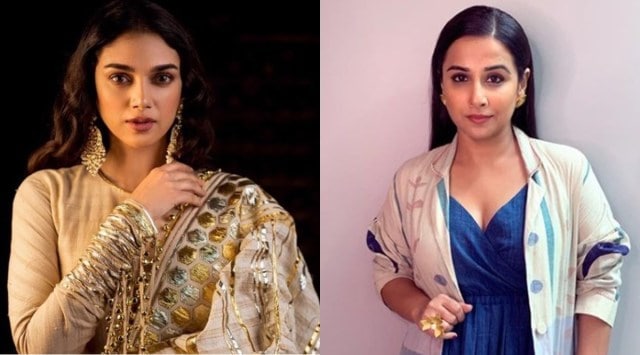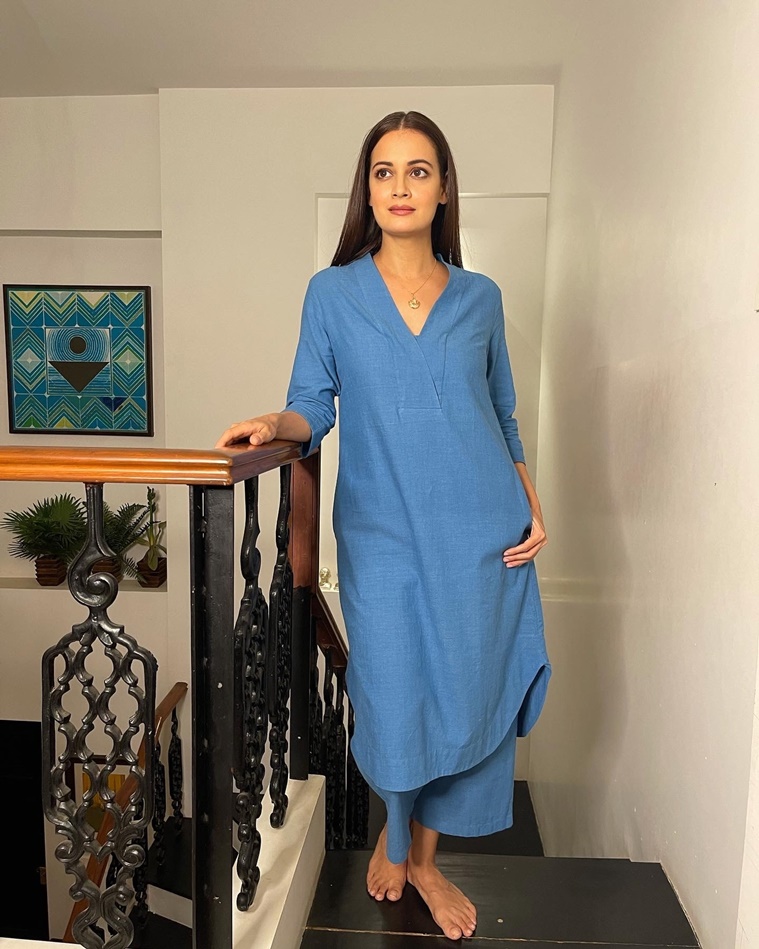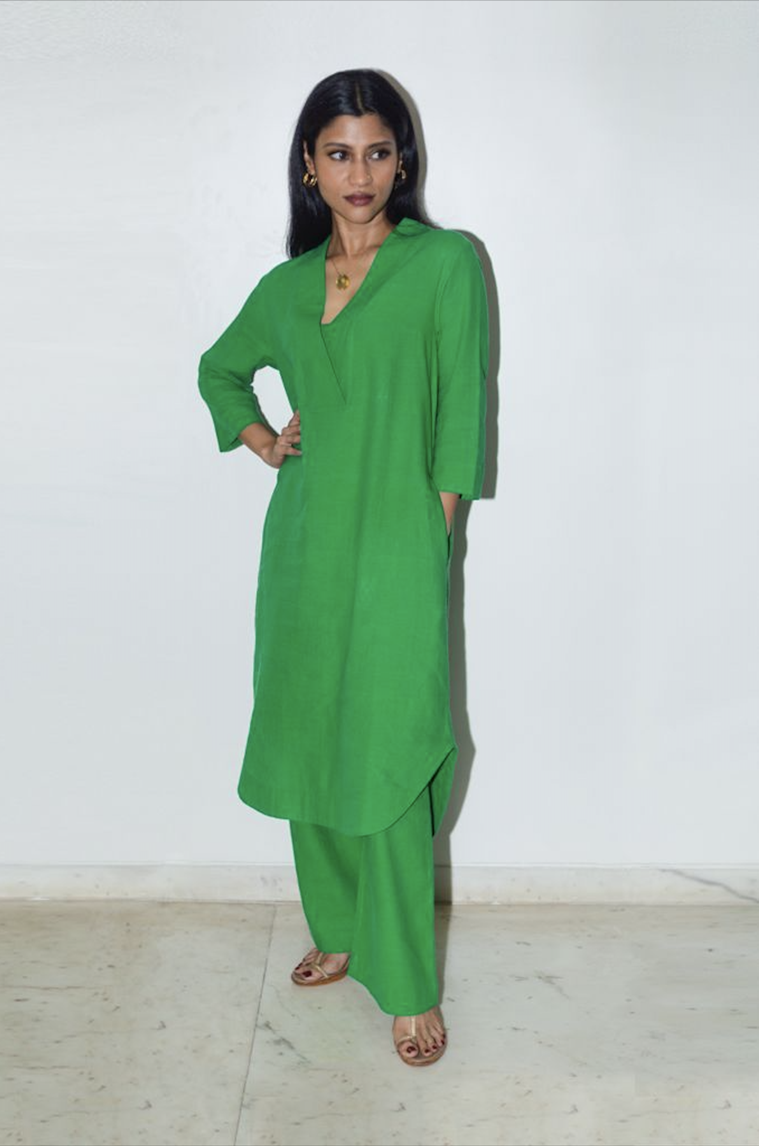- India
- International
‘Fashionable, comfortable fabric for all times’: How khadi is emerging as a sustainable fashion choice
"Khadi fabrics have special comfort, breathability and absorbency due to its yarns being softly twisted in anticlockwise direction using natural fibres"
 Aditi Rao Hydari in a khadi ensemble by Abu Jani Sandeep Khosla, Vidya Balan in a khadi dress by Shuffling Suitcases. (Source: abujanisandeepkhosla/Instagram, balanvidya/Instagram)
Aditi Rao Hydari in a khadi ensemble by Abu Jani Sandeep Khosla, Vidya Balan in a khadi dress by Shuffling Suitcases. (Source: abujanisandeepkhosla/Instagram, balanvidya/Instagram)Khadi emerged as a symbol of resistance as part of Mahatma Gandhi’s Swadeshi movement. In the pre-Independent era, it was referred to as a handwoven cotton cloth made from homespun thread. Over the years, however, it has come to mean clothes woven from silk or wool and spun into a yarn on a charkha or spinning wheel.
Naturally, the fabric, which may have otherwise diverted people’s interest from it for being lacklustre, is now piquing the attention of many. According to a 2017 study ‘An Exploratory Study on Khadi Industry in India‘ published in the SSRN Electronic Journal, the khadi industry has seen a significant rise in sales over the years. In 2016-17, it recorded sales worth Rs 50,000 crores for the first time in India. Uttar Pradesh is known to be the major contributor of cotton khadi, followed by Tamil Nadu and Haryana, while West Bengal is a major contributor in silk khadi. Haryana, on the other hand, is the major contributor of woollen khadi.
Commonly donned by politicians till a time, khadi, today, is being used to weave a range of attire — from kurtas and saris to gowns, shirts and skirts. In fact, a new brand of Indian designers are now focussing on khadi production as a highly-fashionable sustainable alternative. Giving further impetus, even Prime Minister Narendra Modi and several Bollywood celebs are now promoting the use of khadi products. Following Modi’s Mann ki Baat address recently, the Delhi outlet of Khadi & Village Industries Commission (KVIC) recorded a gross sale of Rs 1.02 crore on October 2, marking the “fourth successive year” of the sales crossing Rs 1 crore.
Thanks to all khadi lovers, KVIC’s CP outlet in Delhi recorded gross sale of Rs 1.02 cr on 2nd Oct. It is the 4th successive year that Khadi sale on Gandhi Jayanti has crosses Rs 1 cr mark.Hon’ble PM’s appeal has truly made Khadi the most acceptable brand @PMOIndia @MeNarayanRane pic.twitter.com/UDhtFoOTWi
— Chairman KVIC (@ChairmanKvic) October 4, 2021
Designer Anavila Misra, whose exquisite khadi creations have been worn by celebs like Dia Mirza and Konkona Sen Sharma, tells indianexpress.com, “Khadi is fashionable, it’s how we interpret it and translate it into our life that makes it forever relevant. It is the most apt and comfortable fabric for Indian weather and life.”
 Dia Mirza in Anavila Misra khadi kurta set. (Source: PR Handout)
Dia Mirza in Anavila Misra khadi kurta set. (Source: PR Handout)
Calling it the “fabric of India”, Misra says that khadi is now a “symbol of ultimate luxury”. “It’s not only the symbol of Indian handloom and craft sector it’s the symbol of its resilience and ultimate luxury. I am fascinated by this fabric and the khadi way of life and that led me to experiment with khadi.”
Agrees Abhishek Pathak, founder & CEO, Greenwear Fashion Pvt Ltd, a sustainable fashion brand that promotes khadi attire. “Khadi fabrics have special comfort, breathability and absorbency due to its yarns being softly twisted in anticlockwise direction using natural fibres. It is classic and natural. The possibilities for variation in khadi are endless, it is a fabric for all times. We must understand that khadi is not a specific product. It is a specific process which involves hand spinning, handweaving and handcrafted value additions,” he says.

 Konkona Sen Sharma in an Anavila Misra outfit. (Source: PR Handout)
Konkona Sen Sharma in an Anavila Misra outfit. (Source: PR Handout)
To attract buyers, designers are making sure their khadi products cater to the latest trends and designs. Talking about the growing popularity of khadi, fashion designer Gautam Gupta from the label Asha Gautam states, “There is design intervention which is making it more desirable. Right from making it more drape friendly to textures on it to developing contemporary silhouettes. Today consumers want to indulge in fashion which is indigenous and environment friendly.”
As Gupta points out, the sustainability aspect of khadi has also helped it become a preferred choice amid rising emphasis on eco-friendly living. It does not use machines or energy and therefore has low carbon footprint. It also consumes much less water — about three litres for one metre, compared to 55 litres for one metre mill-produced cloth. Besides, short-staple cotton needed for charkha can be obtained on less fertile land without any agro-chemicals, according to the aforementioned 2017 study.
View this post on Instagram
Khadi is not just about being ‘vocal for local’, it is considered one of the major contributors to the rural economy. According to kviconline.gov.in, a total of 4,98,158 artisans is employed in the khadi across industry zones. “Initially it was the look, feel and uniqueness of khadi fabrics which I really liked. Later, when I began to understand the processes involved in producing these fabrics, I started falling in love with the level of community engagement and the impact potential it has on marginalised communities,” says Pathak.
“Weaving consists of five processes which engage manpower at each level. Usually, the entire family of the weaver gets involved in various processes. For plain woven fabric the weaver earns Rs 25/meter and can earn up to Rs 18000 per month. At least 80 per cent of fabric gets sold as unprocessed fabric to well-established brands and the rest of the fabrics are used for value addition techniques such as dyeing, printing and embroidery,” he adds.
To boost production and thereby income, Greenwear has also introduced solar charkha or ‘solar vastra’ which can produce “four times more yarn than the manual new model charkhas and the drudgery involved is significantly lesser which could allow rural women to manage household obligations without hampering productivity.”
At present, [Greenwear] is working in close association with Bhartiya HaritKhadi Gramodaya Sansthan (BHKGS) which has trained around 3500 rural women across the country in skill of spinning yarns on ‘Solar Charkhas’. It provides training for three months and then facilitates these women by linking them with financial institutions so that they become owners of 10-spindle solar run Charkha which is installed in their households. Hence, these women are able to work from their households while taking care of family and daily chores,” Pathak says.
Misra says, “The khadi industry today stands at a turning point where it can transcend from a rural industry to a modern luxury industry with deep rooted tradition and legacy.”
Despite such promising numbers, the share of khadi fabrics in the total textile production in India stands at less than 10 per cent, Pathak further says. “If only five per cent of Indian villages become solar charkha clusters (around 30,000), it can produce 180 crore kilograms of cotton yarn — which is almost 50 per cent of India’s current cotton yarn capacity-and also generate livelihood for 1.2 crore rural Indians without migrating from their villages.”
📣 For more lifestyle news, follow us on Instagram | Twitter | Facebook and don’t miss out on the latest updates!
More Lifestyle
Apr 26: Latest News
- 01
- 02
- 03
- 04
- 05




































